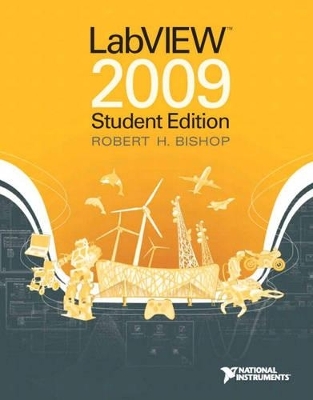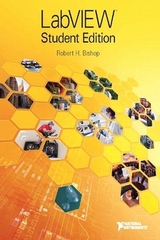
LabVIEW 2009 Student Edition
Prentice Hall
978-0-13-214129-1 (ISBN)
- Titel erscheint in neuer Auflage
- Artikel merken
Preface xvii 1 LabVIEW Basics 1 1.1 System Configuration Requirements 2 1.2 Installing the LabVIEW Student Edition 2 1.3 The LabVIEW Environment 3 1.4 The Getting Started Screen 5 1.5 Panel and Diagram Windows 8 1.5.1 Front Panel Toolbar 10 1.5.2 Block Diagram Toolbar 12 1.6 Shortcut Menus 14 1.7 Pull-Down Menus 16 1.7.1 File Menu 16 1.7.2 Edit Menu 16 1.7.3 View Menu 17 1.7.4 Project Menu 19 1.7.5 Operate Menu 19 1.7.6 Tools Menu 20 1.7.7 Window Menu 22 1.7.8 Help Menu 22 1.8 Palettes 23 1.8.1 Tools Palette 23 1.8.2 Controls Palette 24 1.8.3 Functions Palette 26 1.8.4 Searching the Palettes and Quick Drop 27 1.9 Opening, Loading, and Saving VIs 30 1.10 LabVIEW Help Options 33 1.10.1 Context Help Window 33 1.10.2 LabVIEW Help 34 1.11 Building Blocks: Pulse Width Modulation 35 1.12 Relaxed Reading: Controlling the World's Largest Particle Accelerator 37 1.13 Summary 39 Exercises 41 Problems 45 Design Problems 48 2 Virtual Instruments 52 2.1 What Are Virtual Instruments? 53 2.2 Several Worked Examples 55 2.3 The Front Panel 62 2.3.1 Numeric Controls and Indicators 62 2.3.2 Boolean Controls and Indicators 64 2.3.3 Configuring Controls and Indicators 68 2.4 The Block Diagram 68 2.4.1 VIs and Express VIs 69 2.4.2 Nodes 70 2.4.3 Terminals 71 2.4.4 Wiring 74 2.5 Building Your First VI 77 2.6 Data Flow Programming 82 2.7 Building a VI Using Express VIs 84 2.8 Building Blocks: Pulse Width Modulation 91 2.9 Relaxed Reading: Autonomous Driving in the DARPA Urban Challenge 93 2.10 Summary 96 Exercises 97 Problems 102 Design Problems 106 3 Editing and Debugging Virtual Instruments 111 3.1 Editing Techniques 112 3.1.1 Creating Controls and Indicators on the Block Diagram 112 3.1.2 Selecting Objects 114 3.1.3 Moving Objects 116 3.1.4 Deleting and Duplicating Objects 117 3.1.5 Resizing Objects 117 3.1.6 Labeling Objects 119 3.1.7 Changing Font, Style, and Size of Text 120 3.1.8 Selecting and Deleting Wires 122 3.1.9 Wire Stretching and Broken Wires 123 3.1.10 Aligning, Distributing, and Resizing Objects 128 3.1.11 Coloring Objects 130 3.1.12 Cleaning Up the Block Diagram 137 3.1.13 Routing Wires 139 3.1.14 Reusing Snippets of Code 140 3.2 Debugging Techniques 141 3.2.1 Finding Errors 142 3.2.2 Highlight Execution 144 3.2.3 Single-Stepping Through a VI and Its SubVIs 146 3.2.4 Breakpoints and Probes 147 3.2.5 Navigation Window 152 3.3 Property Nodes 153 3.4 A Few Shortcuts 155 3.5 Building Blocks: Pulse Width Modulation 156 3.6 Relaxed Reading: Using Graphical System Design for Tumor Treatments 158 3.7 Summary 160 Exercises 162 Problems 164 Design Problems 168 4 SubVIs 172 4.1 What Is a SubVI? 173 4.2 Review of the Basics 174 4.3 Editing the Icon and Connector 177 4.3.1 Icons 177 4.3.2 Connectors 180 4.3.3 Selecting and Modifying Terminal Patterns 182 4.3.4 Assigning Terminals to Controls and Indicators 183 4.4 The Help Window 184 4.5 Using a VI as a SubVI 188 4.6 Creating a SubVI from a Selection 191 4.7 Error Checking and Error Handling 193 4.7.1 Automatic Error Handling 193 4.7.2 Manual Error Handling 194 4.7.3 Error Clusters 194 4.8 Saving Your SubVI 195 4.9 The VI Hierarchy Window 196 4.10 Building Blocks: Pulse Width Modulation 198 4.11 Relaxed Reading: Embedded Graphical System Design Empowers Life-Saving Spider Robots 201 4.12 Summary 203 Exercises 204 Problems 207 Design Problems 210 5 Structures 213 5.1 The For Loop 214 5.1.1 Numeric Conversion 216 5.1.2 For Loops with Conditional Terminals 220 5.2 The While Loop 221 5.3 Shift Registers and Feedback Nodes 227 5.3.1 Shift Registers 227 5.3.2 Using Shift Registers to Remember Data Values from Previous Loop Iterations 229 5.3.3 Initializing Shift Registers 231 5.3.4 Feedback Nodes 233 5.4 Case Structures 236 5.4.1 Adding and Deleting Cases 239 5.4.2 Wiring Inputs and Outputs 241 5.5 Flat Sequence Structures 247 5.5.1 Evaluate and Control Timing in a Sequence Structure 248 5.5.2 Avoid the Overuse of Sequence Structures 250 5.6 The Formula Node 250 5.6.1 Formula Node Input and Output Variables 251 5.6.2 Formula Statements 251 5.7 Diagram Disable Structures 254 5.8 Local Variables 255 5.8.1 Creating Local Variables 255 5.8.2 Use Local Variables with Care 257 5.8.3 Initializing Local Variables 257 5.8.4 Memory and Execution-Speed Considerations 258 5.9 Common Programming Techniques 258 5.9.1 Sequential Programming 258 5.9.2 State Programming and State Machines 260 5.9.3 Parallelism 264 5.10 Some Common Problems in Wiring Structures 265 5.10.1 Failing to Wire a Tunnel in All Cases of a Case Structure 265 5.10.2 Overlapping Tunnels 266 5.10.3 Wiring Underneath Rather Than through a Structure 266 5.11 Building Blocks: Pulse Width Modulation 267 5.12 Relaxed Reading: Refining the Process of Steel Recycling 271 5.13 Summary 272 Exercises 275 Problems 279 Design Problems 284 6 Arrays and Clusters 288 6.1 Arrays 289 6.1.1 Creating Array Controls and Indicators 290 6.1.2 Multidimensional Arrays 292 6.2 Creating Arrays with Loops 293 6.2.1 Creating Two-Dimensional Arrays 296 6.3 Array Functions 297 6.3.1 Array Size 297 6.3.2 Initialize Array 298 6.3.3 Build Array 300 6.3.4 Array Subset 301 6.3.5 Index Array 302 6.4 Polymorphism 310 6.5 Clusters 313 6.6 Creating Cluster Controls and Indicators 314 6.6.1 Cluster Order 316 6.6.2 Using Clusters to Pass Data to and from SubVIs 318 6.7 Cluster Functions 319 6.7.1 The Bundle Function 319 6.7.2 The Unbundle Function 323 6.7.3 Creating Cluster Constants on the Block Diagram 323 6.7.4 Using Polymorphism with Clusters 325 6.8 Matrix Data Type and Matrix Functions 326 6.8.1 Creating Matrix Controls, Indicators, and Constants 326 6.8.2 Matrix Functions 328 6.9 VI Memory Usage 330 6.10 Building Blocks: Pulse Width Modulation 331 6.11 Relaxed Reading: User Friendly and Intelligent Acupuncture 334 6.12 Summary 336 Exercises 338 Problems 341 Design Problems 344 7 Charts and Graphs 348 7.1 Waveform Charts 349 7.2 Waveform Graphs 357 7.3 XY Graphs 365 7.4 Customizing Charts and Graphs 368 7.4.1 Axes Scaling 368 7.4.2 The Plot Legend 372 7.4.3 The Graph Palette and Scale Legend 374 7.4.4 Special Chart Customization Features 376 7.4.5 Special Graph Customization Features: Cursor Legend 377 7.4.6 Using Graph Annotations 380 7.4.7 Exporting Images of Graphs, Charts, and Tables 381 7.4.8 Using Context Help 381 7.5 Using Math Plots for 2D and 3D Graphs 382 7.5.1 2D Graphs 382 7.5.2 3D Graphs 386 7.6 Building Blocks: Pulse Width Modulation 390 7.7 Relaxed Reading: Environmental Monitoring in the Costa Rican Rain Forest 391 7.8 Summary 394 Exercises 396 Problems 397 Design Problems 399 8 Data Acquisition 402 8.1 Components of a DAQ System 403 8.2 Types of Signals 404 8.2.1 Digital Signals 406 8.2.2 Analog DC Signals 407 8.2.3 Analog AC Signals 408 8.2.4 Analog Frequency-Domain Signals 409 8.2.5 One Signal--Five Measurement Perspectives 411 8.3 Common Transducers and Signal Conditioning 412 8.4 Signal Grounding and Measurements 416 8.4.1 Signal Source Reference Configuration 416 8.4.2 Measurement System 417 8.5 Analog to Digital Conversion Considerations 422 8.6 DAQ VI Organization 427 8.7 Choosing Your Data Acquisition Device 428 8.7.1 M Series Data Acquisition Devices 429 8.7.2 Low Cost Data Acquisition for Students 429 8.7.3 Simulated Data Acquisition 429 8.7.4 Macintosh, Linux, Palm OS, Windows Mobile for Pocket PC, and Select Windows CE OS Devices 430 8.8 DAQ Hardware Configuration 431 8.8.1 Windows 431 8.8.2 Channels and Tasks 439 8.9 Using the DAQ Assistant 441 8.9.1 DAQmx Task Name Constant 445 8.10 Analog Input 448 8.10.1 Task Timing 448 8.10.2 Task Triggering 449 8.11 Analog Output 453 8.11.1 Task Timing 454 8.11.2 Task Triggering 455 8.12 Digital Input and Output 460 8.13 Building Blocks: Pulse Width Modulation 466 8.13.1 Generating Pulse Width Modulated Signals with Hardware Counters 467 8.13.2 Applications of Pulse Width Modulation 468 8.14 Relaxed Reading: Structural Health Monitoring of the Olympic Venues 469 8.15 Summary 471 Exercises 474 Problems 475 Design Problems 476 9 Strings and File I/O 478 9.1 Strings 479 9.1.1 Converting Numeric Values to Strings with Build Text Express VI 486 9.2 File I/O 487 9.2.1 Writing Data to a File 491 9.2.2 Reading Data from a File 494 9.2.3 Manipulating Spreadsheet Files 495 9.2.4 File I/O Express VIs 498 9.2.5 Obtaining the Path to the System Directories 503 9.3 Building Blocks: Pulse Width Modulation 504 9.4 Relaxed Reading: Optimizing Professional Cyclist Performance 506 9.5 Summary 508 Exercises 509 Problems 511 Design Problems 512 10 MathScript RT Module 516 10.1 What Is MathScript RT Module? 517 10.2 Accessing the MathScript Interactive Window 518 10.2.1 The Command History and Output Windows 520 10.2.2 Viewing Data in a Variety of Formats 521 10.3 MathScript Help 524 10.4 Syntax 526 10.4.1 Key MathScript Functions 535 10.5 Defining Functions and Creating Scripts 536 10.5.1 User-Defined Functions 537 10.5.2 Scripts 540 10.6 Saving, Loading, and Exporting Data Files 543 10.6.1 Saving and Loading Data Files 543 10.6.2 Exporting Data 546 10.7 MathScript Nodes 547 10.7.1 Accessing the MathScript Node 548 10.7.2 Entering Scripts into the MathScript Node 550 10.7.3 Input and Output Variables 550 10.7.4 Script Highlighting 554 10.7.5 Debugging Scripts 556 10.7.6 Saving Scripts from within the MathScript Node 561 10.8 Applications of MathScript RT Module 563 10.8.1 Instrument Your Algorithms 563 10.8.2 Graphical Signal Processing, Analysis, and Mathematics 564 10.8.3 Integrating Measurement Hardware 565 10.9 Building Blocks: Pulse Width Modulation 566 10.10 Relaxed Reading: Acquiring and Analyzing the Bioacoustic Communication of Killer Whales 568 10.11 Summary 570 Exercises 572 Problems 573 Design Problems 574 11 Analysis 576 11.1 Linear Algebra 577 11.1.1 Review of Matrices 577 11.1.2 Systems of Algebraic Equations 581 11.1.3 Linear System VIs 584 11.2 Statistics and Curve Fitting 587 11.2.1 Curve Fits Based on Least Squares Methods 587 11.2.2 Fitting a Curve to Data with Normal Distributions 591 11.2.3 The Curve Fitting Express VI 593 11.3 Differential Equations 597 11.4 Finding Zeroes of Functions 606 11.5 Integration and Differentiation 609 11.6 Signal Generation 611 11.6.1 Normalized Frequency 611 11.6.2 Wave, Pattern, and Noise VIs 615 11.6.3 The Simulate Signal Express VI 618 11.7 Signal Processing 620 11.7.1 The Fourier Transform 620 11.7.2 Smoothing Windows 624 11.7.3 The Spectral Measurements Express VI 629 11.7.4 Filtering 632 11.7.5 The Filter Express VI 641 11.8 Building Blocks: Pulse Width Modulation 644 11.9 Relaxed Reading: Controlling the World's Largest Telescope in Real Time 646 11.10 Summary 648 Exercises 650 Problems 651 Design Problems 651 A Instrument Control 653 A.1 Components of an Instrument Control System 654 A.1.1 What Is GPIB? 654 A.1.2 GPIB Messages 655 A.1.3 GPIB Devices and Configurations 657 A.1.4 Serial Port Communication 659 A.1.5 Other Bus Technologies 661 A.2 Detecting and Configuring Instruments 662 A.2.1 Windows 662 A.2.2 Macintosh OS X 662 A.3 Using the Instrument I/O Assistant 665 A.4 Instrument Drivers 672 A.4.1 Developing Your Own Instrument Driver 679 A.5 Future of Instrument Drivers and Instrument Control 680 A.6 Summary 681 B LabVIEW Developer Certification 684 B.1 Overview of the NI LabVIEW Certification Structure 685 B.2 Logistics of the CLAD Examination 685 B.3 Benefits of CLAD 686 B.4 Sample CLAD Examination 687 B.5 Detailed Sample CLAD Test Solutions 698 B.6 Additional Study Resources 705 B.7 Summary 705 Index 707
| Erscheint lt. Verlag | 18.12.2009 |
|---|---|
| Zusatzinfo | Illustrations |
| Verlagsort | Upper Saddle River |
| Sprache | englisch |
| Maße | 190 x 231 mm |
| Gewicht | 1036 g |
| Themenwelt | Mathematik / Informatik ► Informatik ► Software Entwicklung |
| ISBN-10 | 0-13-214129-9 / 0132141299 |
| ISBN-13 | 978-0-13-214129-1 / 9780132141291 |
| Zustand | Neuware |
| Informationen gemäß Produktsicherheitsverordnung (GPSR) | |
| Haben Sie eine Frage zum Produkt? |
